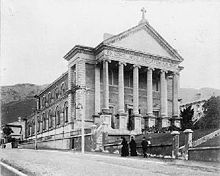|
Roman Catholic Archdiocese of Wellington
The Roman Catholic Archdiocese of Wellington (Archidioecesis Metropolitae Vellingtonensis) is the metropolitan archdiocese of New Zealand. Catholics number about 83,214 (2006 census). Parishes number 22 and the archdiocese extends over central New Zealand between Levin and Masterton in the north to Kaikoura to Westport in the south.[1] The suffragan sees are: HistoryPioneersThe Catholic faith of the new immigrants to Wellington was initially sustained through the efforts of John Fitzgerald who arrived on 31 January 1840. He led the Sunday prayers and organised Christian Doctrine classes. The first resident priest was the Capuchin Father Jeremiah O’Riley who arrived as chaplain to Hon Henry William Petre, a director of the New Zealand Company and one of the founders of Wellington. O’Riley arrived in January 1843 and within a year the first, small Catholic church was built and dedicated to the Nativity. Meanwhile, the Auckland-based French Marists ministered extensively throughout the country and Fr J.B. Compte SM established a permanent mission at Ōtaki in 1844.[2] MaristsIn June 1848, Pope Pius IX divided New Zealand into two dioceses, Auckland and Wellington which consisted of the lower half of the North Island and the whole of the South Island. Bishop Philippe Viard, who arrived in Wellington on the barque "Clara" on 1 May 1850, was the first bishop. With him were five Marist priests, ten lay brothers, two lay male teachers, three Māori and four young women, the "Sisters of Mary" who commenced teaching at what became St Mary's College and Sacred Heart Cathedral School.[2] EstablishmentViard bought and was given land in Thorndon on which his residence, St Mary's Convent and St Mary's Cathedral were built. Garin and Clause went to Nelson to establish the church there. Fr Lampila and two others established a mission in Hawkes Bay. Forest and Huntley worked in the Hutt Valley. Petitjean and Seon travelled extensively throughout the South Island. By 1852 a parish had been established in Whanganui and the Māori mission on the Whanganui River had a resident priest. For ten years, however, Viard received no reinforcements and illness took a toll on his personnel. In March 1860 the Sisters of Mercy arrived from Auckland to take over the works of the four Sisters of Mary.[2] ExpansionIn 1859 three more Marist priests arrived and pastors could be provided to New Plymouth, Christchurch and Dunedin. The discovery of gold in 1857 and after meant a rapid expansion of the Church on the West Coast, and Dunedin became a separate diocese in 1869. Irish priests arrived and followed their compatriots to the diggings. The Sisters of the Missions also arrived to establish schools in Napier (Sacred Heart College Napier and St Joseph's Māori Girls' College) and in Christchurch and Nelson.[2] ArchdioceseViard died on 2 June 1872 and was succeeded by Francis Redwood, who remained ordinary of the diocese for 61 years. The diocese was elevated to an archdiocese on 10 May 1887 and Christchurch became a separate diocese. Thomas O’Shea became his coadjutor bishop in 1913 and remained so for 22 years. Redwood died in 1935 and was succeeded by O’Shea whose archepiscopate lasted for 12 years. Peter McKeefry was appointed coadjutor archbishop in 1947 and succeeded on the death of O’Shea in 1954. McKeefry was appointed a cardinal in 1969 and was assisted by Owen Snedden who was auxiliary bishop from 1962.[2] CardinalsDuring McKeefry's episcopate the Catholic population of Wellington more than doubled and 39 new parishes were established. New orders arrived such as the Cistercians in Hawkes Bay. McKeefry, who became New Zealand's first cardinal in 1969, was succeeded in 1973 by Reginald Delargey who in turn was succeeded, on his death in 1979, by Thomas Williams, who became a cardinal in 1983. In 1980 the archdiocese was split with the creation of the Palmerston North diocese. Williams retired in March 2005 and John Dew was appointed as his replacement. He was made a cardinal in 2015.[2] PresentIn 2019, Dew, addressing the state of the church's buildings and the future of their congregations, stated that soaring insurance costs and a dwindling number of priests meant that the resources of the archdiocese would have to be more efficiently used. He said that fewer resources would be poured into retaining buildings and more attention and energy focused on serving the poor, as required by Pope Francis and the synod. He said that earthquake resilience issues meant that the archdiocese was liable for unsustainable insurance costs and the strengthening of buildings with unacceptable New Building Standard ratings. Already four churches and Sacred Heart Cathedral had been closed because of this. He also stated that some parishes would need to amalgamate to cope with the lack of clergy. He said that the reduced number of priests, which was accelerating each year, meant that in most parishes there was a single priest – often elderly – expected to minister in more than one church. Availability and ability of priests were highly significant factors governing decisions for the future that could not be delayed. Between 2013 and 2017 the archdiocese carried out a parish amalgamation process, which led to the reduction in parishes from 47 to 22, and many of the new parishes had too many churches, presbyteries, and other buildings.[3] OrdinariesPhilippe Viard was vicar apostolic of the Diocese of Wellington from 1848 until 1860 when he became the Bishop of Wellington. Francis Redwood was bishop of that diocese until 1887 when he became archbishop of the Archdiocese of Wellington (created in that year) and Metropolitan of New Zealand. All incumbents since then carry those latter two titles.
Current Bishops
Other bishopsCoadjutor archbishops
Auxiliary bishops
Other priests of the diocese who became bishops
Secondary schools
Child sexual abuse casesDocumented cases of child sexual abuse by Catholic priests and brothers in the Wellington area include:
See also
External links
References
|
|||||||||||||||||||||||||||||||||||||||||||||||||||||||||||||||||||||||||||||||
